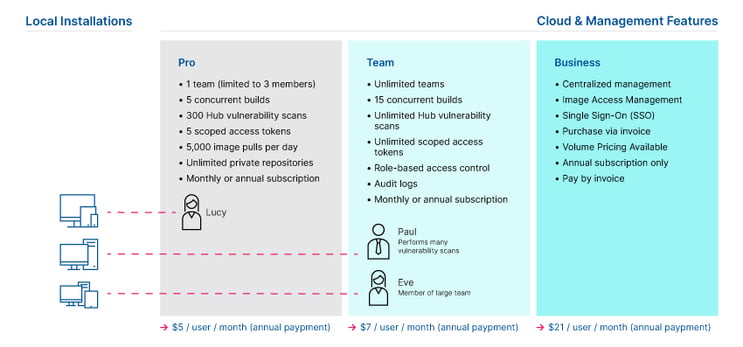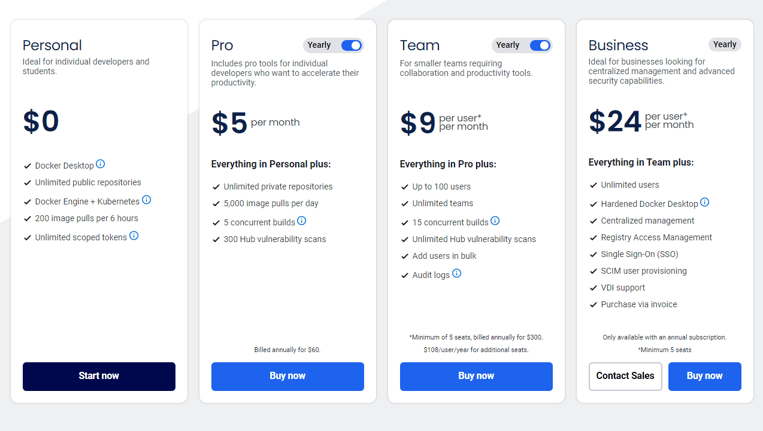The new Oracle Java licensing: What you can do now
Oracle Java licensing has become noticeably more expensive and complex in 2023. This has mainly to...
Have you heard? Using Docker Desktop for container management will now cost money!
In mid 2021, the announcement that Docker Desktop would become licensable for larger enterprises in 2022 caused quite a stir. As a result, many emotional articles have appeared online - probably in no small part due to the bitter memory of Oracle's commercialization of Java SE, which was also widely used, two years ago.
With the motto of “complaining is useless”, however, we will explain how the new licensing model of Docker Desktop works and what you should consider in detail. As Software Asset Management (SAM) specialists, our focus is to protect you. Which information you need to understand your risk exposure, which very concrete steps you could take now to manage the financial effects, and which licensing traps should be avoided.
Does your organization have more than 250 employees? Or more than $10 million in annual revenue? For organizations of that size, Docker Desktop now requires a per-user paid subscription. Yes, it’s no longer free.
Docker has become a popular technology over the last couple of years, for instance, you’ll find many Docker users in R&D departments. Docker is a technical tool, so it is not as widely used as Microsoft's Office 365, for example, and therefore does not have the same priority among software asset managers.
However, commercializing Docker now requires addressing software compliance and software spend. Therefore you should at minimum find out what Docker’s footprint in your company looks like.
Good news: If you have tools and processes in place for Software Asset Management, Docker might be “just” another user-based software product.
Make sure that you don't get the topics mixed up: this is about licensing docker, not about licensing software that runs in containers. However, the latter is also a current challenge for license managers.
Bottom line: You must investigate the extent to which Docker is used in your organization and start to manage it. Or at least, add it to your list for next month.

Docker Engine is the core component of this runtime solution. It comprises the dockerd daemon which manages assets like images, containers and networks, and it comprises interfaces such as CLI and REST API.
Docker Desktop is not just the user interface, as some folks think. It is really a bundle of components such as Docker Engine, Docker Compose, integrated Kubernetes, automated installation and updates, simple control of host resources, and developer tools. In other words, it's all you need to make your life easy if you want to go for Docker.
Using Docker Engine without using Docker Desktop to get around the commercial licensing is theoretically possible. However, this path requires specialized knowledge and a complex DIY setup, so it is not an attractive, scalable solution for enterprises that rely on well-supported software stacks.
Docker Hub is Docker’s cloud platform. Besides a large collection of public container images, it offers advanced features such as automated image builds from GIT servers, private image repositories, and vulnerability scans of images. Registered Docker Hub users can become members of teams which belong to organizations. This structure is important for enterprise level management of Docker users and licenses as we will outline later.
In a nutshell: If you want to manage and run software in Docker containers, most likely your choice is Docker Desktop. The toolset to easily manage this architecture is no longer free.
Docker Desktop now requires a per-user paid subscription for professional use in larger companies (250+ employees OR $10 million annual revenue). The tolerance phase is over end of January 2022.
Docker comes with three types of subscriptions or “plans”. PRO, TEAM and BUSINESS are compared in the chart below. All plans allow users to install Docker Desktop on all of their devices, but there are differences regarding some other features.
Example: Lucy has three devices with Docker Desktop installed. Since she only uses Docker Desktop, the PRO subscription is sufficient for her. The company pays $5 per month for Lucy. Coworkers Paul and Eve also have devices with installations of Docker Desktop, but use Docker's advanced cloud features on Docker Hub and therefore require TEAM subscriptions, which cost $7 per month.

Update:
Please note that the license prices mentioned in this article are no longer up to date.
For an updated overview of the current license prices, please refer to the attached screenshot. This shows the current prices on 05.01.2024.
Please note that these prices may change again. We recommend that you check the current prices to obtain the latest status.
Updated prices on 05.01.2024 for annual subscription:

At first glance, it seems easy to decide which type of subscription is best for each individual user. However, a closer look at the license terms shows there are important differences in terms of governance: Costs have to be paid and hundreds or thousands of users and subscriptions should be managed as easily as possible.
As mentioned before, subcriptions are managed in Docker Hub using teams and organizations.
All subscription types can be cancelled up to 30 days before the contract expires. Due to an auto-renewal clause all Docker subscriptions remain in place unless you actively cancel them. This clause can be negotiated with Docker.
Also consider the audit clause in the license terms. With the contract, you grant Docker and/or its representatives an audit right and agree to collect and retain data relevant to the licensing for at least 3 years:
“[…] Such records shall be kept for at least three years following the end of the quarter to which they pertain. Upon prior notice, Docker or its representative may inspect such records to confirm your compliance with the terms of this Agreement. […]” (Source)
This clause leaves you vulnerable to compliance fines if your record keeping isn’t good or reliable. So it’s important to manage your contract data - and using a professional tool like USU Software Asset Management makes this easy.
A simple approach to Docker Desktop licensing is to estimate how many Docker users you have in the company. Search for Docker installations in the software inventory and check whether you know the owners of the identified devices. Otherwise, you must work with an assumption, for example, 1.5 devices per employee. Keep in mind that Docker Desktop didn’t require a license until version 4.0.
With this identified or estimated number of Docker users, you can make a projection that assumes each receives a TEAM subscription for $7 per month, if paid annually. You can already use these numbers for budget planning. For the known named users you can also obtain TEAM subscriptions from the Docker Hub portal: in the portal you create your organization and one or more teams, and invite people to the teams. Additional TEAM subscriptions can be obtained with a few clicks.
If you face high subscription costs and want to understand such in detail, plus investigate optimization potentials, you obviously need to take a closer look: First, you should do a regular inventory of Docker Desktop installations and the allocation to employees so you get reliable figures for planning. This lets you compare the acquired Docker subscriptions with actual usage at any time, creating transparency and software compliance.
Next, you adjust the number and type of your subscriptions to the real needs. You can easily have subscriptions that are not assigned to any users (overlicensing). There will probably always be such a gap, but it should be as small as possible to avoid wasting money.
There is a second type of gap that can be addressed for optimization: As with any desktop software in large organizations, there are inevitably users who have installed the software but are no longer actively using it, for example, in the last 90 days. If these users can be identified by measuring software usage (metering), Docker Desktop can be uninstalled to reduce the number of unneeded subscriptions and save monthly subscription costs (re-harvesting).
The supreme discipline is to not simply license everything that is found in the software inventory, but to standardize and actively control Docker usage. This requires decisions to be made about where and how Docker should be used.
A software request management system should make it easy for employees to request and return the software with just a few clicks. Software costs should ideally be charged according to software consumption. This ensures that people throughout the company pay attention to the costs in their area of responsibility and ensure the adequate use of Docker in the work context.
Once you have gained experience with Docker usage and its dynamics in your organization, you can also consider mixing monthly and annual contract models. For the minimum number of users you have always needed over time (base load), buy the less expensive subscriptions with annual payment, i.e. with one-year contract commitment. For the "peaks", buy short-term subscriptions with monthly payments at higher monthly costs. These subscriptions can be cancelled at short notice if they are no longer required.
In its FAQs, Docker recommends using a professional solution for a reliable software inventory:
“[Question] How do I know how many people are using Docker Desktop in my organization? [Answer] If your organization uses a Software Asset Management tool, you may be able to use this to determine how many users have Docker Desktop installed. […]” (Source)
SAM is more critical than ever for business success. The commercialization of Docker underlines its increasing importance in times of digitalization and transition to cloud. However, the "per-user" subscription approach that Docker is taking here is not new, but is similar to traditional "named user" licensing.
At USU, we’re here to talk with you about hot licensing topics as well as evergreen topics. We've been managing named-user licenses for decades, and we're applying our proven best practices to new business models and technologies like containers and SaaS. Our Software Asset Management solution is used worldwide to cover all the essential aspects such as inventory, software compliance, metering and reharvesting, software request management, and cost charging.
Oracle Java licensing has become noticeably more expensive and complex in 2023. This has mainly to...
This article explains the main drivers forSoftware Asset Management, and why a software license...
Software vendors are determined to recover declining revenues as customers are moving to the cloud....